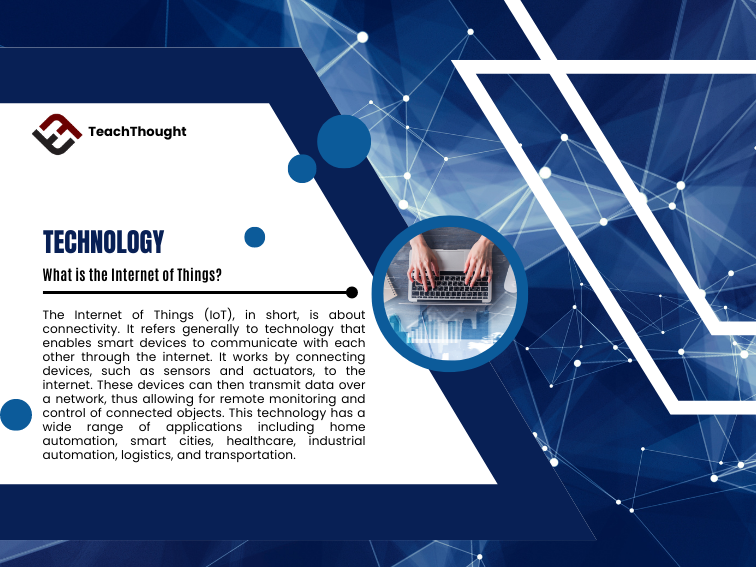
What Is The Internet Of Things? A One-Sentence Definition
by TeachThought Staff
For those who just came for the definition, the internet of things is the connection of smart electronic devices in our daily lives.
For the sake of simplicity, think of the phrase not in its entirety–the internet of things–but rather by stressing the last word: the internet of things.
Examples Of The Internet Of Things
A few examples of the ‘things’ that make up the internet of things as we know it today include:
- smart automotive technology
- smart thermostats
- smart televisions
- smart refrigerators
- smart garages
- smart lights
- smart curtains
Notice the word ‘smart’ prefacing everything? Eventually, that distinction won’t be necessary. In many countries and cities anyway (who knows how the planet ultimately will and won’t ‘develop’), the expectation will likely simply be that all ‘things’ be ‘smart.’
How Does The Internet Of Things Work?
The easiest way to understand the internet of things is to first consider the internet as we know it today–a network of computers and servers that ‘talk’ to each other. People, of course, use this ‘internet’ to talk to one another (through messaging and social media, for example).
The internet of things is a concept that can get complicated fast. It would have been difficult to predict the way the internet as we know it today would affect our daily lives. The same with cellphones before that, the automobile before that, electricity before that, and so on.
Part of this is because of how our brains work. We make sense of ideas through what we already know (i.e., schema). If you’re learning the rules for a new board game, it’s natural to compare it to games you already know–and of course, you would. How could you possibly use knowledge you don’t have to make new knowledge?
Summary
The Internet of Things (IoT) is a term that describes the connection between physical objects and the internet. It is a network of billions of devices connected to the internet, allowing them to interact and exchange data with each other. IoT devices are equipped with sensors that collect data from their environment and use it to facilitate communication between devices. These internet-connected devices allow for better integration between devices, creating efficient and automated processes. An IoT platform is also used to manage these connections, enabling them to communicate in different ways. Additionally, machine learning can be used to improve the connection between devices by further understanding collected data and adjusting responses accordingly. In conclusion, the term ‘Internet of Things’ refers to the ability to connect millions or even billions of devices to the internet in order to collect data, integrate services and automate processes.
The Internet of Things (IoT), in short, is about connectivity. It refers generally to technology that enables smart devices to communicate with each other through the internet. It works by connecting devices, such as sensors and actuators, to the internet. These devices can then transmit data over a network, thus allowing for remote monitoring and control of connected objects. This technology has a wide range of applications including home automation, smart cities, healthcare, industrial automation, logistics, and transportation. With IoT, it is possible to monitor and control physical objects remotely using sensors that are connected to the internet via Wi-Fi or cellular networks. The data collected by these sensors can be analyzed and used for predictive maintenance or to improve efficiency in various industries. Additionally, IoT allows for automated processes that save time and money while providing more accurate results than manual processes. As technology continues to evolve, IoT will become increasingly important in our everyday lives as well as in businesses around the world.
More Examples Of The Internet Of Things Application Devices
IoT devices are objects connected to the Internet of Things (IoT) system. Examples of IoT devices range from everyday items such as a connected car, smart home devices, and wearable technology, to more industrial applications such as sensor-connected machines used in factories. IoT applications allow users to use IoT devices to collect data, connect devices and control them remotely. For example, a smart home can be connected to the internet and can be controlled through voice commands or a mobile app. Smart home devices include lights, thermostats, security systems and appliances that can be monitored remotely.
Similarly, IoT sensors are used to track various activities such as temperature, humidity, motion, and sound in order to provide real-time data on these activities. They also connect various devices together so they can interact with each other. Through the use of IoT applications and devices, users are able to monitor their environment more easily and accurately than ever before.
What Is The Internet Of Things? The Definition Of ‘The Internet Of Things‘